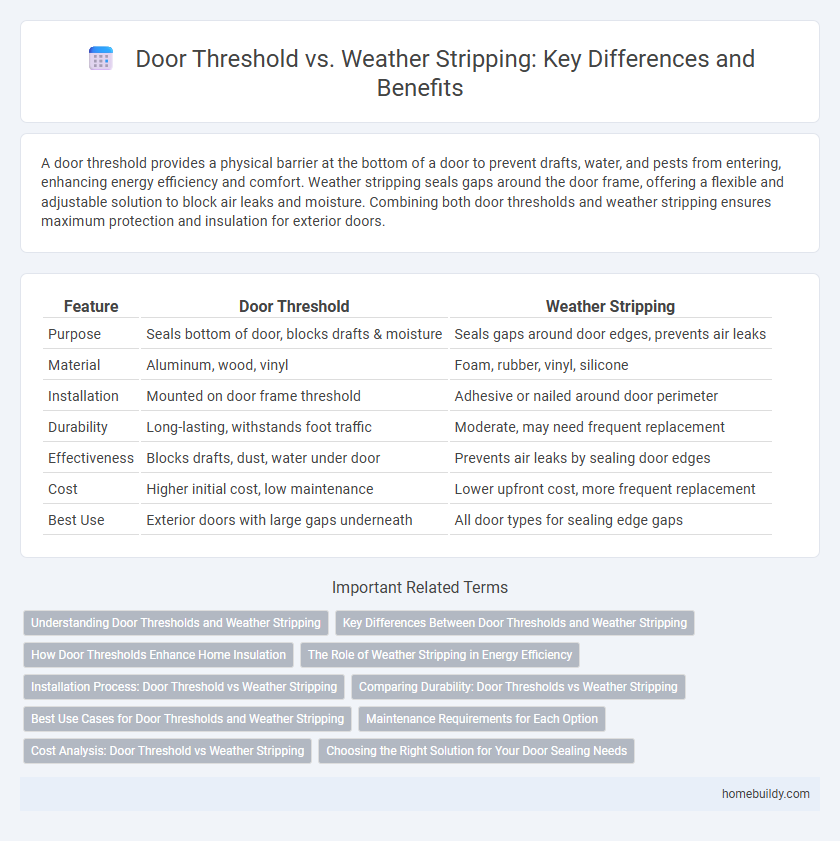A door threshold provides a physical barrier at the bottom of a door to prevent drafts, water, and pests from entering, enhancing energy efficiency and comfort. Weather stripping seals gaps around the door frame, offering a flexible and adjustable solution to block air leaks and moisture. Combining both door thresholds and weather stripping ensures maximum protection and insulation for exterior doors.
Table of Comparison
| Feature | Door Threshold | Weather Stripping |
|---|---|---|
| Purpose | Seals bottom of door, blocks drafts & moisture | Seals gaps around door edges, prevents air leaks |
| Material | Aluminum, wood, vinyl | Foam, rubber, vinyl, silicone |
| Installation | Mounted on door frame threshold | Adhesive or nailed around door perimeter |
| Durability | Long-lasting, withstands foot traffic | Moderate, may need frequent replacement |
| Effectiveness | Blocks drafts, dust, water under door | Prevents air leaks by sealing door edges |
| Cost | Higher initial cost, low maintenance | Lower upfront cost, more frequent replacement |
| Best Use | Exterior doors with large gaps underneath | All door types for sealing edge gaps |
Understanding Door Thresholds and Weather Stripping
Door thresholds serve as a structural barrier at the base of a door, providing stability and sealing the gap between the door and the floor to prevent drafts, moisture, and pests. Weather stripping complements door thresholds by sealing gaps around the sides and top of the door, enhancing energy efficiency and indoor comfort. Combining both door thresholds and weather stripping creates a comprehensive defense against air leaks and environmental elements, optimizing insulation and protection.
Key Differences Between Door Thresholds and Weather Stripping
Door thresholds provide a solid barrier at the base of a door to prevent drafts, water, and pests from entering, offering structural support and durability. Weather stripping consists of flexible materials installed around the door frame to create a tight seal that blocks air leaks and improves energy efficiency. While door thresholds address gaps beneath the door, weather stripping targets gaps around the door edges, making both essential for comprehensive insulation.
How Door Thresholds Enhance Home Insulation
Door thresholds create a solid barrier at the base of doors, preventing drafts and reducing heat loss more effectively than weather stripping alone. By sealing gaps where air can enter or escape, thresholds contribute significantly to maintaining consistent indoor temperatures and improving energy efficiency. Their durable construction also adds an extra layer of protection against moisture infiltration, enhancing overall home insulation.
The Role of Weather Stripping in Energy Efficiency
Weather stripping plays a crucial role in enhancing energy efficiency by sealing gaps around door thresholds to prevent air leaks and reduce heat loss. Unlike door thresholds that primarily act as a physical barrier against drafts and moisture, weather stripping provides a flexible, airtight seal that adapts to door movement and irregular surfaces. Effective weather stripping reduces heating and cooling costs by maintaining consistent indoor temperatures and minimizing energy consumption.
Installation Process: Door Threshold vs Weather Stripping
The installation process of a door threshold typically involves securing a solid strip of material, such as aluminum or wood, at the base of the door frame using screws or adhesive, ensuring a durable and permanent seal against drafts and moisture. Weather stripping requires precise measurement and cutting of flexible materials like foam, rubber, or vinyl, which are then applied along the door edges with adhesive backing or fasteners to seal gaps effectively. Compared to weather stripping, door threshold installation is often more labor-intensive but provides a robust barrier, whereas weather stripping offers easier installation with customizable sealing on movable door parts.
Comparing Durability: Door Thresholds vs Weather Stripping
Door thresholds are typically made from durable materials such as aluminum, wood, or composite, offering long-lasting protection against wear and environmental elements. Weather stripping, while effective at sealing gaps and preventing drafts, is usually composed of softer materials like rubber, foam, or vinyl, which can degrade faster due to friction and exposure. When comparing durability, door thresholds provide a more robust and enduring barrier, especially in high-traffic areas, whereas weather stripping requires more frequent replacement and maintenance.
Best Use Cases for Door Thresholds and Weather Stripping
Door thresholds are best suited for sealing gaps beneath exterior doors to block drafts, water, and pests, providing a durable barrier against outdoor elements. Weather stripping excels at sealing the small gaps around door frames and movable parts, improving energy efficiency by preventing air leaks. Combining both door thresholds and weather stripping optimizes insulation and protection for exterior doors in varying weather conditions.
Maintenance Requirements for Each Option
Door thresholds require periodic cleaning and occasional replacement to maintain a proper seal, especially in high-traffic areas where wear is frequent. Weather stripping demands more frequent inspection and replacement due to its material susceptibility to cracking, shrinking, or detachment from the door frame over time. Proper maintenance of both components ensures optimal energy efficiency and protection against drafts, moisture, and pests.
Cost Analysis: Door Threshold vs Weather Stripping
Door thresholds typically involve a higher upfront cost ranging from $20 to $100 due to materials like aluminum or wood and professional installation expenses. Weather stripping is more cost-effective, usually priced between $5 and $30, and can be easily installed by homeowners, reducing labor costs. Over time, door thresholds offer durable protection against drafts and moisture, potentially lowering energy bills more significantly than weather stripping, which may require frequent replacement.
Choosing the Right Solution for Your Door Sealing Needs
Door threshold and weather stripping each serve distinct roles in door sealing, with thresholds providing a durable barrier at the bottom of doors while weather stripping offers flexible, airtight seals along door edges. For enhanced energy efficiency and protection against drafts, dust, and moisture, combining a well-fitted door threshold with quality weather stripping delivers optimal results. Selecting the right solution depends on the door material, climate conditions, and desired level of insulation to ensure maximum performance and longevity.
door threshold vs weather stripping Infographic

 homebuildy.com
homebuildy.com